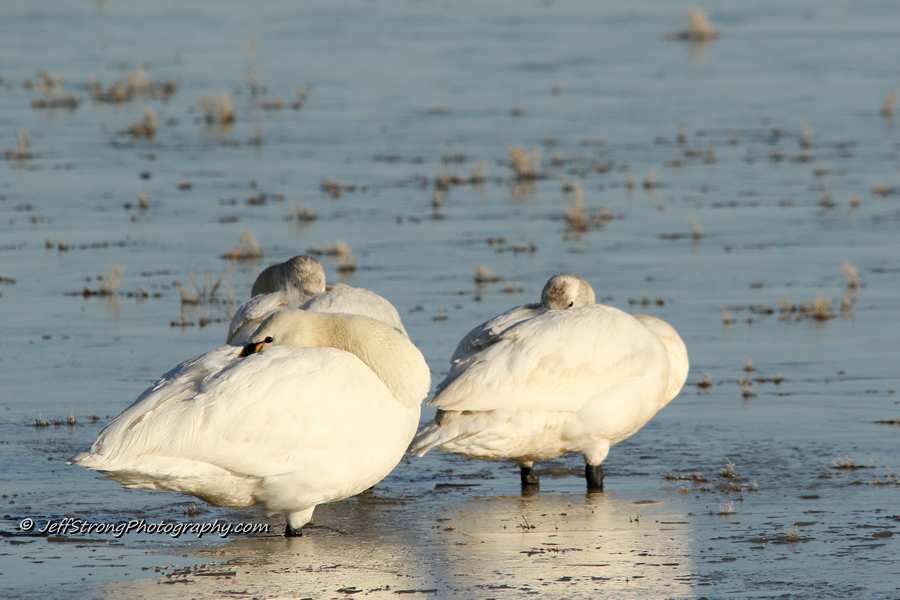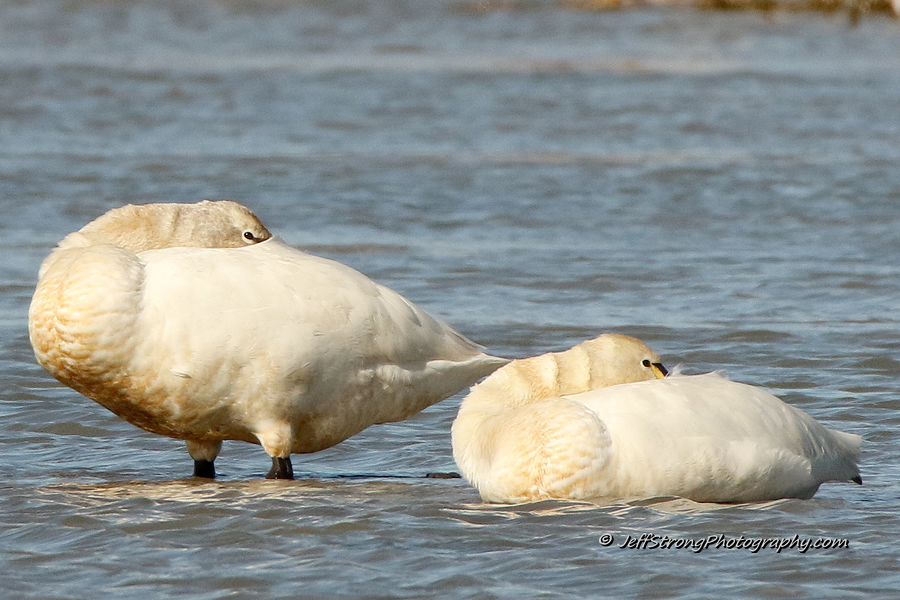It might seem like a simple question to ask regarding what does a tundra swan eat, but the answer does, indeed, have implications on their migration, which, I will admit, is very interesting to me, to say the least.
A huge part of this fascination with both tundra swans, in particular, and just overall bird migration, in general, comes from the spring and fall amassing of thousands of tundra swans on the Bear River Migratory Bird Refuge each year.
It’s a grand spectacle to both see and hear, especially during spring migration when their courtship and mating rituals oftentimes fill the airways along the self-guided auto tour loop with vocalizations and squabbles that can be heard miles away at times, especially at night.
For birders and outdoor photographers alike, such as myself, it is an incredible time to visit the refuge to witness one of the great sights and sounds of nature as the migrating tundra swan takes center stage and puts on quite a show for a few weeks or more.
So what does the tundra swan eat?
Tundra swans migrate thousands of miles twice per year between their wintering grounds and the far reaches of the northernmost parts of the arctic region known as the tundra.
Their migration route and timing is pretty well tied to their diet and a constant need for food to fuel them for the long journey of both spring and fall migration.
Tundra swans eat mainly plant matter, including tubers, stems, and leaves of aquatic vegetation such as Carex sedges, saltmarsh starwort, alkali grass, and also pondweed. Seeds and algae are also part of their diet, as well as some grains from harvested fields of corn, barley, and soybean during fall migration when they are available.
Is the tundra swan a herbivore?
Although the tundra swan is, in fact, a herbivore and mainly eats a variety of plant matter, some swans do consume mollusks, small invertebrates, and arthropods.
How does a tundra swan eat?
A swan eats aquatic vegetation like other waterfowl do, by tipping up and reaching its head under the water’s surface to pull out the aquatic vegetation it is after. This is called “tipping” as the bird actually tips forward until its tail feathers are pointed straight upward, and its head is under the water.
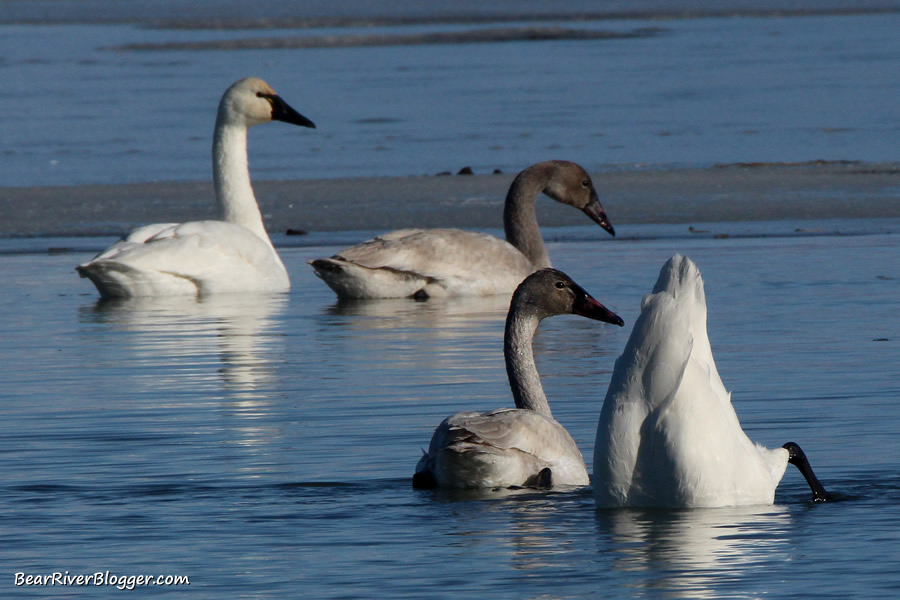
This means tundra swans look for shallow wetlands and marshes where the vegetation is within their reach. Tundra swans don’t swim underwater like some diver duck species do to get to the vegetation, so water depth is important and why swans will utilize and prefer some areas over others for their stopovers during migration.
Today, while at Farmington Bay WMA, I noticed an interesting bit of tundra swan behavior I was not aware of. From what it appeared, tundra swans shuffle their feet from time to time as they fed in shallow water, quite possibly to help them dig in the shallow water to make the underwater vegetation more accessible.
I was able to capture a few minutes of this most interesting behavior with the following video. Watch the swan on the left as it shows this interesting behavior several times as it feeds.
Swans need to constantly be feeding during migration, so where they stop to feed and rest is crucial to their migration, and these shallow wetlands are the most important habitat along their route.
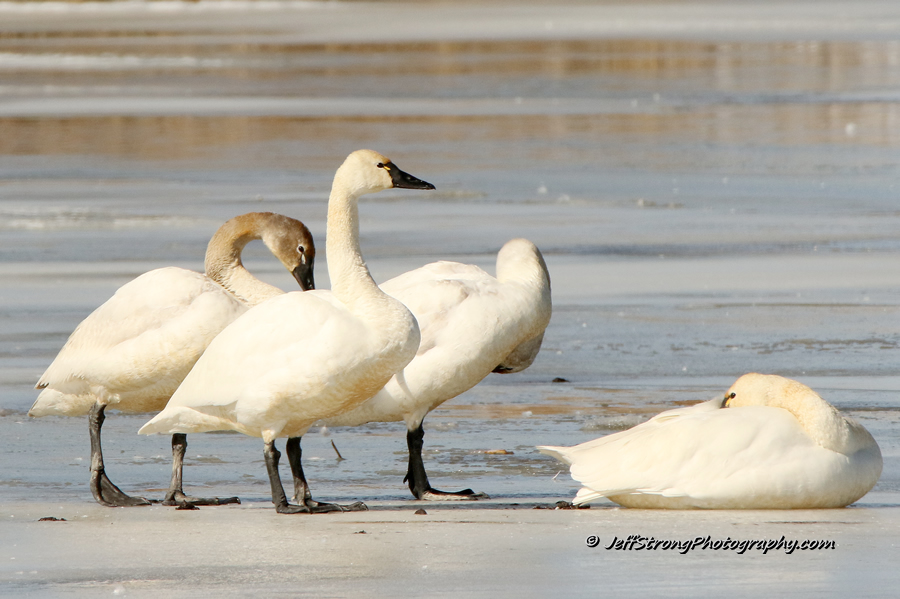
How is their diet tied to migration?
It is well-known food is a major factor in bird migration and with the tundra swan, that assumption holds true as well. Swans fly thousands of miles in a few short weeks and are one of the largest birds in North America, so their dietary needs for migration are great.
Much of the tundra swan’s diet is tied to shallow wetlands along their migration route, such as the marshes along the eastern shore of the Great Salt Lake and adjoining Bear River Refuge, for example. When these waterways freeze, the swan’s food supply is cut off for the most part.
Swans migrate south to find open water and food, and when local waters freeze, it’s a signal to head further south to a warmer climate to find open water to accessible aquatic food. Swans will migrate back north in early spring to traditional breeding grounds to breed and raise another family of swans for the year.
Some areas with large agricultural activity do help feed migrating swans for a short while, but typically when freeze-up occurs, the swans will leave within a couple days or so to find another shallow wetland further south.
I actually saw this phenomenon last fall on the refuge as one day I witnessed countless flocks of swans acting like they were migrating south yet again. Both small and large flocks of swans were taking off and forming the traditional “v” pattern in flight and headed in a southward direction, gaining a bit of altitude as they went.
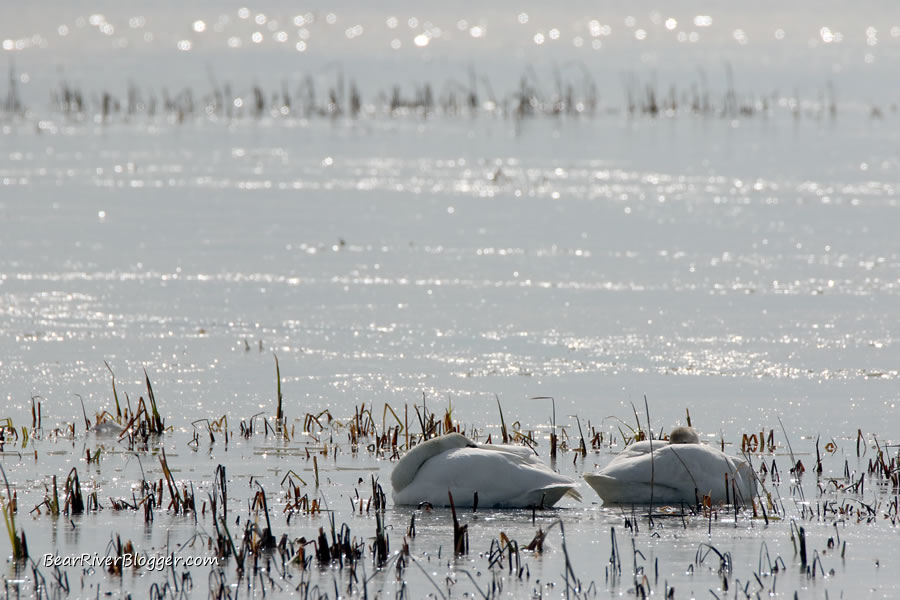
That night we had a hard freeze, and the next morning I went to the refuge again and found nearly the entire refuge was frozen over. I didn’t see or hear a swan the entire morning, where only 12 hours earlier, I saw thousands.
How these beautiful birds knew of an impending hard freeze is beyond my scope of understanding the natural world but, rest assured, they did, in fact, migrate out that very night.
One interesting fact I have recently seen on the Bear River Migratory Bird Refuge in the past several years is not all of the swans will leave after the first hard freeze. It has been known each winter over the past few seasons, a small band of tundra swans has stayed behind and actually broke with tradition and wintered on the refuge for some reason.
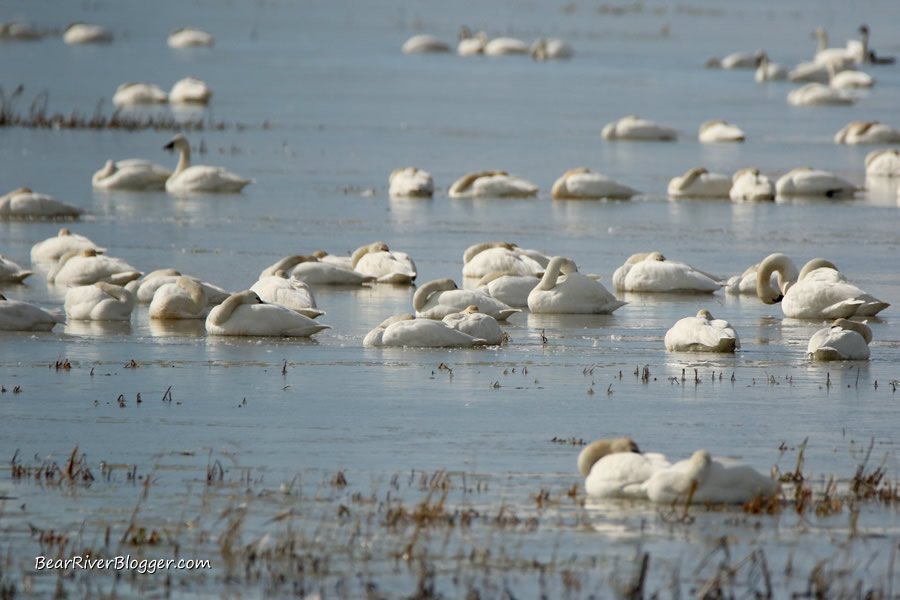
Each winter over the past 3 or 4 years or so, I have actually seen this small flock of tundra swans toughing it out in very harsh conditions on the refuge. This includes years where we have stretches of weeks well below freezing for the high temperature for the day.
I don’t know why or even how they can manage such a brutal environment as their aquatic food supply is cut off for a couple months, but for some unknown reason, a few tundra swans, usually numbering in the low hundreds or so, has been sticking it out on the refuge during winter the past few years.
Tundra swan vs. trumpeter swan
Within the past few years, here in Northern Utah, we have been seeing a surge in trumpeter swan sightings during fall migration. This year, in fact, the Utah swan hunt was closed down 16 days early due to the quota of 20 trumpeter swans being harvested already.
Telling the difference between a trumpeter swan and a tundra swan can be a challenge on the wing, but there are ways to discern the difference between the two species of swans.
Tundra swans have a distinctive yellow eye patch where the beak and eye connect, while trumpeter swans have no eye patch but have pink or deep orange around the edge of their beaks. Tundra swans have heads that are a bit more rounded, while trumpeter swans have a flatter beak. Trumpeter swans are also much larger in overall size than the tundra swan.
Look at the following two images of swans. The first is a trumpeter swan, showing the classic flatter head and beak, and is overall larger than the tundra swan. The second image is of a tundra swan showing the yellow eye patch. Both swans can be seen migrating together, and it can be hard to tell the difference between the two at a distance.

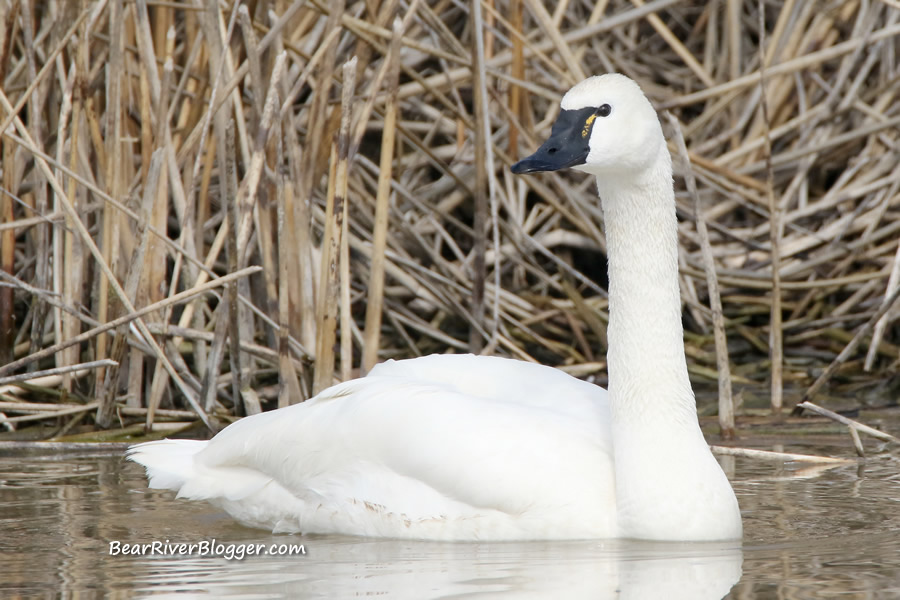
The importance of the Bear River Migratory Bird Refuge for the tundra swan.
The Bear River Migratory Bird Refuge is a major stopping point along the tundra swan migration route here in the western United States. Tens of thousands of swans visit the refuge each fall and spring to rest and feed for a short time.
The nearly 77,000-acre wildlife preserve is managed by the U.S. Fish and Wildlife Service for migrating birds and some, such as the tundra swan, are of a high priority on how the refuge habitat is managed. Shallow wetlands are provided for migrating waterfowl so swans, ducks, and geese can stopover and feed in these shallow-water aquatic buffets.
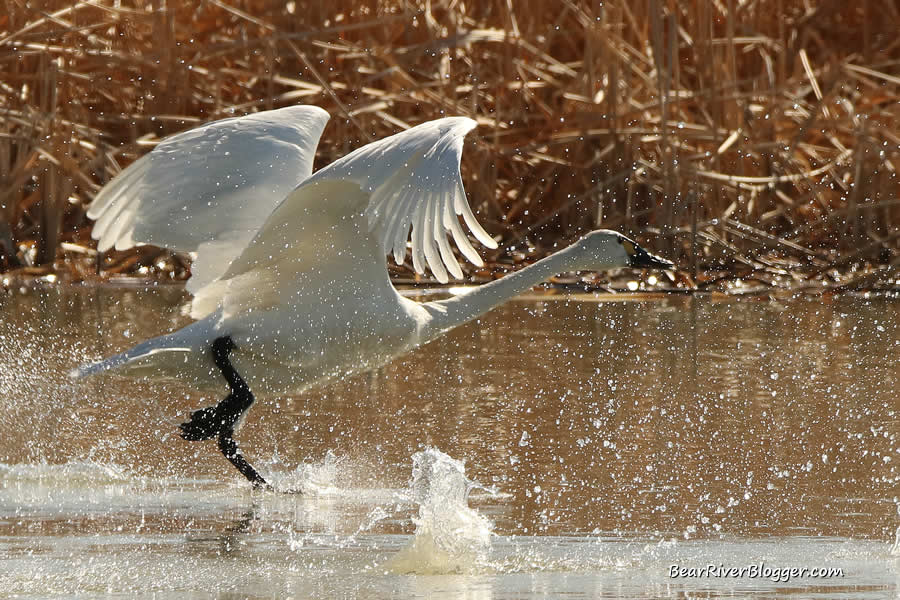
Geese are a lot more adaptable than the tundra swan and can feed on a variety of grasses and even agricultural pastures when food sources are frozen over, but the swan needs these shallow wetlands, even if for just a few crucial weeks of the year, to make it to their wintering grounds in California.
The Bear River Migratory Bird Refuge and marshes along the eastern shore of the Great Salt Lake provide critical feeding areas for a large portion of the western population of tundra swans as they migrate and, in turn, offer the bird watcher a great opportunity to view and photograph these majestic birds fulfilling one of the great wonders of nature, bird migration.
If you are into nature like I am, things such as birds, butterflies, and all of the other fascinating creatures in our world, visit the subscribe page and subscribe to my blog. I photograph the Bear River Migratory Bird Refuge and nearby areas year-round and hope to bring to you the incredible sights and sounds I am so lucky to observe on my travels so you can enjoy them too.
